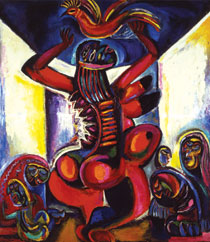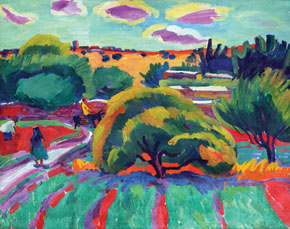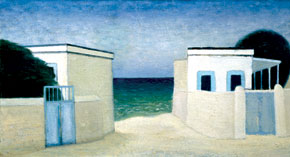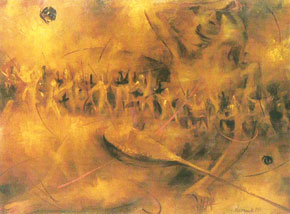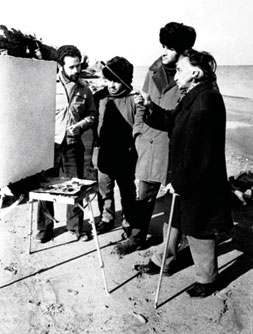
The Absheron School of art emerged in Azerbaijan in the mid-20th century. The artists were known in Azerbaijani as the Absheronchu, meaning closely involved in the life of Absheron. They travelled to the many villages and settlements on the Absheron Peninsula and depicted on their canvases the daily life of the local people, without idealisation and with their own view of the world. The term Absheronchu was often not intended as a compliment, however. When their works were exhibited in Baku, fingers would be pointed and the comment hissed ‘That’s Absheronchu!’ The depictions of Absheron people growing flowers, shoeing horses and bulls, making abgora (a juice from unripe grapes) and of children flying kites or riding donkeys were very different from the work of other artists and a source of irritation to officials.
The group was accused of being ‘anti-Soviet’, as its members acted according to their convictions. The informal leader, Mirjavad Mirjavadov, was 32 in 1955, his younger brother Tofig Javadov was 30, Rafael Muradov was 23 and Farhad Khalilov was only 21. The public followed the Absheronchus’ every move with great interest, as they were so unusual for their time. The artists turned their back on the artistic principles of Socialist Realism, which dominated during the communist era, and avoided toadying to any ideology. Independence and freedom of this kind could be considered, to put it mildly, as wilfulness and it was there for all to see.
When Soviet leader Nikita Khruschev expressed his fury at the work of avant-garde artists displayed at the Manège exhibition hall in Moscow in 1962, the repercussions were felt throughout the USSR. In Baku local ideologists took a harsh stance towards the Absheron School, but were often uncertain how to deal with them. They banned the exhibition of any works by the Absheronchu which did not meet communist ideals, putting the artists under moral and financial pressure, as it was through exhibiting that the artists were able to sell their work. Undaunted, the Absheronchu failed to conform.
Mirjavad
Mirjavad Mirjavadov (1923-1992) can be cited as an inspiration for all the Absheronchu painters. While studying at the Azimzade Azerbaijan State Art School, Mirjavad happened upon some magazine reproductions of works by the French Post-Impressionist Paul Cézanne. He was so amazed by Cézanne’s style that the Socialist Realism promoted by the school seemed insipid. When he went to St Petersburg with his peers to take examinations for admission to the Repin Institute of Fine Arts, Mirjavad decided on a different use for his time, fearing that the art training would be as ideologically narrow as in Baku. He went to the State Hermitage in order to study their Cézanne collection.
Ideological constraints meant that the Cézannes were not on display. So, Mirjavad made a blunt request to the director of the museum, ‘Show me the Cézannes or I’ll kill you!’ The director did let him look through the works of Cézanne and other artists and even make copies. He researched in most of the city’s galleries and museums for some six years (1949-1955), studying the aesthetic origins of national art from around the world. However, Mirjavad did not find what he was looking for and returned home.
The artist could not find anywhere to live in Baku, so he went to a friend’s summer house in the Absheron village of Buzovna, where he was to stay nearly ten years. He explored the art of the rock carvings at Gobustan, traditional miniature painting and Azerbaijani mythology and folk art. By the time he was 37, the artist’s style was known as Mirjavad’s view. He had finally found what he was looking for, not in St Petersburg, but in his native land.
His work was a breath of fresh air through Azerbaijan’s visual arts. When shortly afterwards, other artists chose Mirjavad’s view, the Absheron School was born.
This work reflected the richness of the world with remarkable use of colour, at the same time stripping bare human emotions and the struggle between Good and Evil. The paintings were not accepted for exhibition by state officials, although it is obvious that they rescued the visual arts from drab monotony. The artist combined traditional Azerbaijani styles with modern and avant-garde trends, which came as a shock to many. He could be said to have done for art what Vagif Mustafazadeh did for music when he combined traditional Azerbaijani mugham themes with jazz.
In the 1970s, Mirjavad continued to use motifs from folklore and national traditions, protesting in the flow of colours at the indifference to the threat of war hanging over our world. In the 1980s the grotesque featured even more in his work. He combined fairy tales and reality, giving figurative interpretations of mugham and carpet imagery. The artist penetrated into deeper layers of reality making use of the plasticity of colour.
Phaeton (1985) and Humay is a Bird of Peace (1986) are examples of this.
The authorities were resolute in their opposition to Mirjavad. It wasn’t until 1987, during the era of perestroika, when the artist was 64, that he had his first personal exhibition and even this required the persistent intervention of famous Soviet author Chingiz Aitmatov. Later, he had exhibitions in Moscow and also abroad. Sadly, by this time the artist was suffering from brain illness and had to spend the money from commissions on medical treatment. He died in 1992, leaving an indelible stamp as a ‘man of faith’ in the history of Azerbaijan’s visual arts.
Broad school
In the 1960s, Mirjavad’s younger brother Tofig Javadov (1925-1963), Ashraf Murad (1925-1979), Gorkhmaz Efendiyev (1928-1993), Muslim Abbasov (1931-1993) and Rasim Babayev (1927-2007) all created work that went beyond the traditions of Soviet art. The Absheron School was joined by the young Farhad Khalilov, Mirnadir Zeynalov, Kamal Ahmad, Alovsat Aliyev, Rafael Muradov and others. Although most of the Absheronchus’ work could not be shown in the exhibition halls, the artists showed their paintings in their studios on an individual basis. The art-loving public was fed up with the formulaic painting of the communist regime.
Tofig Javadov
Right from his time at the Azimzade Art School, Tofig Javadov displayed his independent way of thinking through original paintings featuring common motifs of everyday working life and the unique Absheron landscape.
Unlike his brother Mirjavad, Tofig turned the ‘Absheronchu view’ onto scenes from Soviet industrial life. He thereby showed the possibility of taking a different, creative stance towards familiar motifs within the narrow framework of Socialist Realism. Examples include Oil Tanks (1962) and Industrial Motif (1960). We can see ‘Tofig’s view’ on different themes in other genres, for example, in Portrait of Tofig (1955), Buzovna (1960) and Wind (1963). His work was characterized by geometric analysis of shape and figure and the juxtaposition of black with bright colours. He achieved harmony of colour in his work so that even black itself acted not as a separator, but as a connector, allowing the expression of fine, lyrical nuances alongside the sharp definition of his figures, objects and nature motifs. Tofig Javadov’s sudden, tragic death did not allow him to complete the artistic exploration he had started so successfully and with such enthusiasm. The artist, who suffered from impaired vision, fell on the rails as he ran to catch a train near Moscow, mistaking the connection between coaches for the carriage door.
The struggle for ideological and artistic style, which began in the 1950s and 60s, expanded in the 70s, playing a major role in the recognition of Azerbaijani art both in the then Soviet Union and beyond. Among the other young artists who played a tangible role in this process, seeking to breathe the fresh air of exploration into the older generation of Azerbaijani art, was Kamal Ahmad (1940-1994).
Kamal Ahmad
Kamal Ahmad was spiritually close to the Javadov brothers and the other Absheroni artists. While features reminiscent of those artists were stronger in his earlier works, by the 1980s and 90s Kamal Ahmad’s paintings were more distinctive. It is as though he tested human emotions against artistic criteria in works such as In the Painter´s Studio (1986) and Self-Portrait on the Crucifixion (1994). He sought to dramatize reality and sharpened images through use of the grotesque. The artist used decorative colour and plastic expressiveness, which carried the symbolic meaning of the original Absheronchu primitiveness. This allowed him to reflect the emotional values of eternal Good and Evil, love and hate, hope and despair from their origins to the modern-day.
Farhad Khalilov
At a time when to be considered an Absheronchu bore a heavy financial and moral burden, many people were surprised to see Farhad Khalilov, who completed his art education in Moscow, return to his ideological friends in Baku. Logically, the young artist, whose father, Gurban Khalilov, occupied a top position as chairman of the Supreme Soviet of the Azerbaijan Soviet Socialist Republic, should not have been alongside artists who were branded ‘anti-Soviet’. Or to take the point further, he should not have been chosen chairman of the Artists´ Union of Azerbaijan in 1987, notwithstanding the insistence of the majority. After his election, senior officials were surprised that he was still not a member of the Communist Party. At that time the election of a 41-year-old artist without party affiliation to a senior position was a first for the Soviet Union. In fact, this was at the beginning of the end, as there were just four years left until the collapse of the USSR.
Farhad Khalilov’s earlier works, all Absheron scenes painted after his return to Baku, show flickers of his understanding of life and artistic interpretation. These include Old Mulberry Tree (1967) and Road to the Sea (1965). Shortly afterwards, his landscapes were distinguished by compactness of meaning and conventionality of artistic interpretation. This can be seen in paintings such as Buzovna (1983) and Sunny Day (1989) where colour is used laconically. Freedom of artistic expression and the use of poetic symbols helped him to create not a copy of life but its image.
Nazim Rahmanov
Nazim Rahmanov, who belonged to the younger generation of Absheronchu, began his career by painting large-scale thematic canvases, compatible with the pulse of the time, but he soon found spiritual comfort through reflection of personal feelings and the inner world. He took traditional themes of land and people for many of his works, but gave them his own interpretation with a message for the viewer.
Strong use of colour helps to convey his topics more poetically and emotionally. Elsewhere, Nazim Rahmanov gave preference to deformations of shape and figure, merging his attitude to an image or event with impressions from various symbolic and philosophical patterns. His series People and Time, which includes later works such as Pharaoh, Emperor and Abel and Cain (1995), has a philosophical purpose and invites the viewer to draw conclusions from the obvious and expected outcomes of contradictory emotions which dominate over human intentions.
Alovsat Aliyev
Alovsat Aliyev (1943-1988) was an artist who consistently displayed the traditions of the Absheron School in his work. He lived in the Absheron village of Buzovna and devoted practically all his work to Absheron. His paintings, which express a tangible sincerity towards life, reflect the harsh Absheron landscape, everyday life and material culture. He revealed previously unseen aesthetics in the most ordinary motifs in works such as Buzovna. Autumn (1970) and Heyrati Cockerel (1981).
Rafael Muradov
Rafael Muradov was taking his first shaky steps in the visual arts in the 1960s, when the ‘severe style’ dominated Soviet art. His creative purpose was to oppose the ‘severe style’ and swim against the current. His inclination to the Absheron School was a deliberate step, although based somewhat on youthful passion. In his 40 years of creative work he has kept alive the dignity peculiar to this school and its sincerity. He does not use high-flown topics or mysterious motifs. He has found what he is looking for in nature and the abundance of Absheron as well as in the life of his contemporaries. This can be seen in works such as Khazri (1992), the name of the north wind that blows in from the Caspian.
Mirnadir Zeynalov
Another artist spiritually close to the Absheron School is Mirnadir Zeynalov. While his work is sometimes dominated by motif and sometimes by idea, it is always full of emotion. The combination of silence with philosophical, emotional and artistic expression is felt in works such as Lone Tree (1974).
Legacy
Artists of different ages have benefited from the traditions of the Absheron school, from the graphic master Alekber Rzaguliyev to Qayyur Yunus and Hamza Abdullayev. While the term Absheronchu was once a reproach, it is now a badge of honour for those artists who withstood the pressures of the Soviet period and created some of the finest work in Azerbaijan’s visual arts of the 20th century.
About the author: Ziyadkhan Aliyev is an Honoured Art Worker of the Republic of Azerbaijan. He has conducted thorough research into Azerbaijani art and written widely about it.
The group was accused of being ‘anti-Soviet’, as its members acted according to their convictions. The informal leader, Mirjavad Mirjavadov, was 32 in 1955, his younger brother Tofig Javadov was 30, Rafael Muradov was 23 and Farhad Khalilov was only 21. The public followed the Absheronchus’ every move with great interest, as they were so unusual for their time. The artists turned their back on the artistic principles of Socialist Realism, which dominated during the communist era, and avoided toadying to any ideology. Independence and freedom of this kind could be considered, to put it mildly, as wilfulness and it was there for all to see.
When Soviet leader Nikita Khruschev expressed his fury at the work of avant-garde artists displayed at the Manège exhibition hall in Moscow in 1962, the repercussions were felt throughout the USSR. In Baku local ideologists took a harsh stance towards the Absheron School, but were often uncertain how to deal with them. They banned the exhibition of any works by the Absheronchu which did not meet communist ideals, putting the artists under moral and financial pressure, as it was through exhibiting that the artists were able to sell their work. Undaunted, the Absheronchu failed to conform.
Mirjavad
Mirjavad Mirjavadov (1923-1992) can be cited as an inspiration for all the Absheronchu painters. While studying at the Azimzade Azerbaijan State Art School, Mirjavad happened upon some magazine reproductions of works by the French Post-Impressionist Paul Cézanne. He was so amazed by Cézanne’s style that the Socialist Realism promoted by the school seemed insipid. When he went to St Petersburg with his peers to take examinations for admission to the Repin Institute of Fine Arts, Mirjavad decided on a different use for his time, fearing that the art training would be as ideologically narrow as in Baku. He went to the State Hermitage in order to study their Cézanne collection.
Ideological constraints meant that the Cézannes were not on display. So, Mirjavad made a blunt request to the director of the museum, ‘Show me the Cézannes or I’ll kill you!’ The director did let him look through the works of Cézanne and other artists and even make copies. He researched in most of the city’s galleries and museums for some six years (1949-1955), studying the aesthetic origins of national art from around the world. However, Mirjavad did not find what he was looking for and returned home.
The artist could not find anywhere to live in Baku, so he went to a friend’s summer house in the Absheron village of Buzovna, where he was to stay nearly ten years. He explored the art of the rock carvings at Gobustan, traditional miniature painting and Azerbaijani mythology and folk art. By the time he was 37, the artist’s style was known as Mirjavad’s view. He had finally found what he was looking for, not in St Petersburg, but in his native land.
His work was a breath of fresh air through Azerbaijan’s visual arts. When shortly afterwards, other artists chose Mirjavad’s view, the Absheron School was born.
This work reflected the richness of the world with remarkable use of colour, at the same time stripping bare human emotions and the struggle between Good and Evil. The paintings were not accepted for exhibition by state officials, although it is obvious that they rescued the visual arts from drab monotony. The artist combined traditional Azerbaijani styles with modern and avant-garde trends, which came as a shock to many. He could be said to have done for art what Vagif Mustafazadeh did for music when he combined traditional Azerbaijani mugham themes with jazz.
In the 1970s, Mirjavad continued to use motifs from folklore and national traditions, protesting in the flow of colours at the indifference to the threat of war hanging over our world. In the 1980s the grotesque featured even more in his work. He combined fairy tales and reality, giving figurative interpretations of mugham and carpet imagery. The artist penetrated into deeper layers of reality making use of the plasticity of colour.
Phaeton (1985) and Humay is a Bird of Peace (1986) are examples of this.
The authorities were resolute in their opposition to Mirjavad. It wasn’t until 1987, during the era of perestroika, when the artist was 64, that he had his first personal exhibition and even this required the persistent intervention of famous Soviet author Chingiz Aitmatov. Later, he had exhibitions in Moscow and also abroad. Sadly, by this time the artist was suffering from brain illness and had to spend the money from commissions on medical treatment. He died in 1992, leaving an indelible stamp as a ‘man of faith’ in the history of Azerbaijan’s visual arts.
Broad school
In the 1960s, Mirjavad’s younger brother Tofig Javadov (1925-1963), Ashraf Murad (1925-1979), Gorkhmaz Efendiyev (1928-1993), Muslim Abbasov (1931-1993) and Rasim Babayev (1927-2007) all created work that went beyond the traditions of Soviet art. The Absheron School was joined by the young Farhad Khalilov, Mirnadir Zeynalov, Kamal Ahmad, Alovsat Aliyev, Rafael Muradov and others. Although most of the Absheronchus’ work could not be shown in the exhibition halls, the artists showed their paintings in their studios on an individual basis. The art-loving public was fed up with the formulaic painting of the communist regime.
Tofig Javadov
Right from his time at the Azimzade Art School, Tofig Javadov displayed his independent way of thinking through original paintings featuring common motifs of everyday working life and the unique Absheron landscape.
Unlike his brother Mirjavad, Tofig turned the ‘Absheronchu view’ onto scenes from Soviet industrial life. He thereby showed the possibility of taking a different, creative stance towards familiar motifs within the narrow framework of Socialist Realism. Examples include Oil Tanks (1962) and Industrial Motif (1960). We can see ‘Tofig’s view’ on different themes in other genres, for example, in Portrait of Tofig (1955), Buzovna (1960) and Wind (1963). His work was characterized by geometric analysis of shape and figure and the juxtaposition of black with bright colours. He achieved harmony of colour in his work so that even black itself acted not as a separator, but as a connector, allowing the expression of fine, lyrical nuances alongside the sharp definition of his figures, objects and nature motifs. Tofig Javadov’s sudden, tragic death did not allow him to complete the artistic exploration he had started so successfully and with such enthusiasm. The artist, who suffered from impaired vision, fell on the rails as he ran to catch a train near Moscow, mistaking the connection between coaches for the carriage door.
The struggle for ideological and artistic style, which began in the 1950s and 60s, expanded in the 70s, playing a major role in the recognition of Azerbaijani art both in the then Soviet Union and beyond. Among the other young artists who played a tangible role in this process, seeking to breathe the fresh air of exploration into the older generation of Azerbaijani art, was Kamal Ahmad (1940-1994).
Kamal Ahmad
Kamal Ahmad was spiritually close to the Javadov brothers and the other Absheroni artists. While features reminiscent of those artists were stronger in his earlier works, by the 1980s and 90s Kamal Ahmad’s paintings were more distinctive. It is as though he tested human emotions against artistic criteria in works such as In the Painter´s Studio (1986) and Self-Portrait on the Crucifixion (1994). He sought to dramatize reality and sharpened images through use of the grotesque. The artist used decorative colour and plastic expressiveness, which carried the symbolic meaning of the original Absheronchu primitiveness. This allowed him to reflect the emotional values of eternal Good and Evil, love and hate, hope and despair from their origins to the modern-day.
Farhad Khalilov
At a time when to be considered an Absheronchu bore a heavy financial and moral burden, many people were surprised to see Farhad Khalilov, who completed his art education in Moscow, return to his ideological friends in Baku. Logically, the young artist, whose father, Gurban Khalilov, occupied a top position as chairman of the Supreme Soviet of the Azerbaijan Soviet Socialist Republic, should not have been alongside artists who were branded ‘anti-Soviet’. Or to take the point further, he should not have been chosen chairman of the Artists´ Union of Azerbaijan in 1987, notwithstanding the insistence of the majority. After his election, senior officials were surprised that he was still not a member of the Communist Party. At that time the election of a 41-year-old artist without party affiliation to a senior position was a first for the Soviet Union. In fact, this was at the beginning of the end, as there were just four years left until the collapse of the USSR.
Farhad Khalilov’s earlier works, all Absheron scenes painted after his return to Baku, show flickers of his understanding of life and artistic interpretation. These include Old Mulberry Tree (1967) and Road to the Sea (1965). Shortly afterwards, his landscapes were distinguished by compactness of meaning and conventionality of artistic interpretation. This can be seen in paintings such as Buzovna (1983) and Sunny Day (1989) where colour is used laconically. Freedom of artistic expression and the use of poetic symbols helped him to create not a copy of life but its image.
Nazim Rahmanov
Nazim Rahmanov, who belonged to the younger generation of Absheronchu, began his career by painting large-scale thematic canvases, compatible with the pulse of the time, but he soon found spiritual comfort through reflection of personal feelings and the inner world. He took traditional themes of land and people for many of his works, but gave them his own interpretation with a message for the viewer.
Strong use of colour helps to convey his topics more poetically and emotionally. Elsewhere, Nazim Rahmanov gave preference to deformations of shape and figure, merging his attitude to an image or event with impressions from various symbolic and philosophical patterns. His series People and Time, which includes later works such as Pharaoh, Emperor and Abel and Cain (1995), has a philosophical purpose and invites the viewer to draw conclusions from the obvious and expected outcomes of contradictory emotions which dominate over human intentions.
Alovsat Aliyev
Alovsat Aliyev (1943-1988) was an artist who consistently displayed the traditions of the Absheron School in his work. He lived in the Absheron village of Buzovna and devoted practically all his work to Absheron. His paintings, which express a tangible sincerity towards life, reflect the harsh Absheron landscape, everyday life and material culture. He revealed previously unseen aesthetics in the most ordinary motifs in works such as Buzovna. Autumn (1970) and Heyrati Cockerel (1981).
Rafael Muradov
Rafael Muradov was taking his first shaky steps in the visual arts in the 1960s, when the ‘severe style’ dominated Soviet art. His creative purpose was to oppose the ‘severe style’ and swim against the current. His inclination to the Absheron School was a deliberate step, although based somewhat on youthful passion. In his 40 years of creative work he has kept alive the dignity peculiar to this school and its sincerity. He does not use high-flown topics or mysterious motifs. He has found what he is looking for in nature and the abundance of Absheron as well as in the life of his contemporaries. This can be seen in works such as Khazri (1992), the name of the north wind that blows in from the Caspian.
Mirnadir Zeynalov
Another artist spiritually close to the Absheron School is Mirnadir Zeynalov. While his work is sometimes dominated by motif and sometimes by idea, it is always full of emotion. The combination of silence with philosophical, emotional and artistic expression is felt in works such as Lone Tree (1974).
Legacy
Artists of different ages have benefited from the traditions of the Absheron school, from the graphic master Alekber Rzaguliyev to Qayyur Yunus and Hamza Abdullayev. While the term Absheronchu was once a reproach, it is now a badge of honour for those artists who withstood the pressures of the Soviet period and created some of the finest work in Azerbaijan’s visual arts of the 20th century.
About the author: Ziyadkhan Aliyev is an Honoured Art Worker of the Republic of Azerbaijan. He has conducted thorough research into Azerbaijani art and written widely about it.
